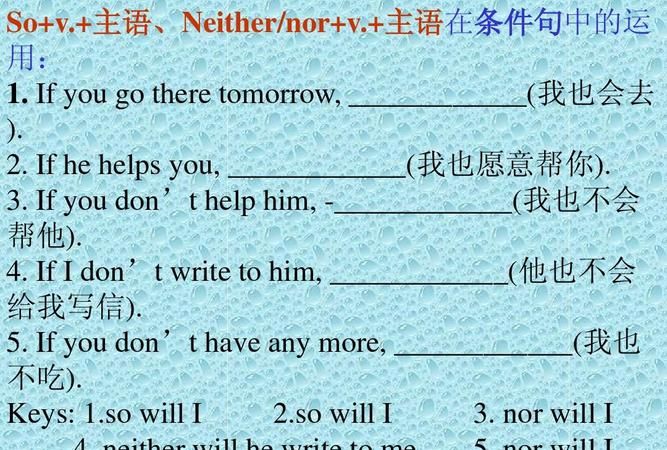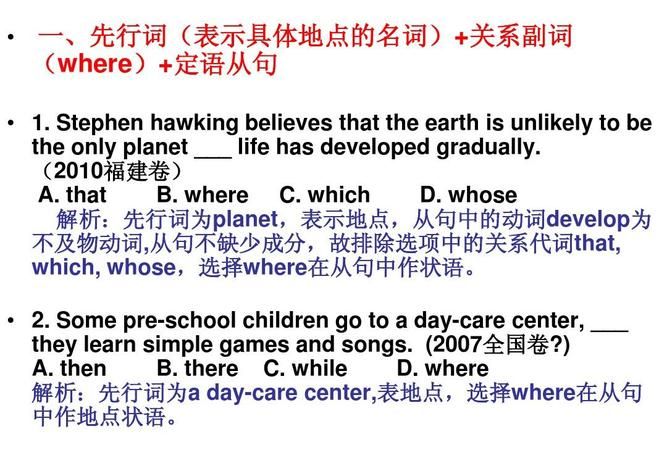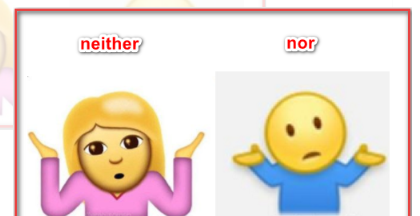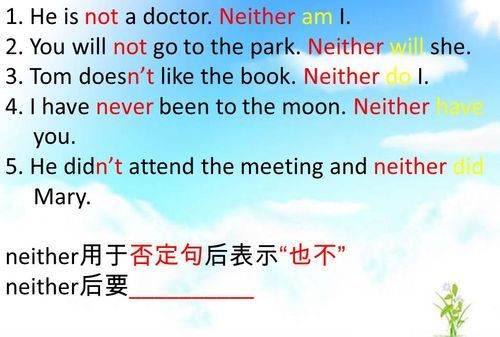本文目录
neither nor either or both and not only but also
neither nor
用作形容词。起定语作用,常放在单数名词前。
either or、
either...or...意为"或者……或者……;不是……就是……"之意。表示两者之一,连接句子中两个并列的成分。
not only but also、
直接放句首就行了
not but
not that …… , but that…… 是用“not ……, but ……”连接两个that从句,所以你说的Not that 主语 谓语 宾语 but that主谓宾 这种句型是可以用的,时态要根据句意决定 1 这一句式在句中作状语时,相当于 not because …..., but because ……,可以换用

Neithernor的用法
neither nor的用法在英语学习中是比较重要的一个知识点,也是广大学生比较容易混淆的知识点之一,它的用法很多。接下来我在这里给大家带来 neither nor的用法在英语学习中是比较重要的一个知识点,也是广大学生比较容易混淆的知识点之一,我们一起来看看吧!
neithernor的用法
neither...nor...表示"既不……也不……".其含义是否定的,可连接任意两个并列的成份.
例如:
She likes neither butter nor cheese.(连接名词)
她既不喜欢黄油也不喜欢乳酪.
She is neither clever nor hardworking.(连接形容词)她既不聪明,又不勤奋. 此句中neither...nor...连接两个宾语.
当neither...nor...连接两个主语时,也应遵循"就近原则".
例如: Neither he nor she is at home today.(连接代词)今天他和她都不在家. 若将neither...nor...句型变为肯定句,只需把neither...nor...改为both...and...即可,同时谓语动词必须用复数形式.
a.当主语不是同一个人或物时,nor和neither可互换,当主语是同一个人或物时,只能用nor.
例如:I don't know,nor do I care.我不知道,也不关心. b.当并列分句有两个以上时,只能用nor. 例如:You can't sing ,nor can I ,nor can she.你不会唱歌,我不会,她也不会.
either or 与 neither nor 用法区别
either与neither可用作形容词、代词、副词和连词等,它们的用法如下:
一、用作形容词.起定语作用,常放在单数名词前.either 表示“这个或者那个”; neither 表示“既非这个、也非那个,两者皆非的”.如:
You may use either book .两本书你可以随便用一本.
Neither answer is right . 两个答案都不对.
二、用作代词.范围多限定于两者之间,常用作主语.作主语时后面跟单数动词.either 表示 “ 二者之一 ” ; neither 表示 “ 两者都不 ” ,其反义词是 both .如:
Either of the knives is useful . 两把刀都有用.
Neither of them was in good health,but both worked very hard . 他们两人身体都不好,但都努力地工作.
三、用作副词.either 只用于否定句中,表示 “ 也(不) ” ; neither 通常用在句子(或简略答语)的开头,表示 “ 也不 ” ,其后要用倒装语序(即:将主语放在助动词、情态动词、连系动词 be 之后).如:
I don’t speak French.She doesn’t,either .
( = Neither I nor she speaks French . ) 我不会讲法语,她也不会讲法语.
If she won’t go,neither shall I .
( = If she won’t go,I won’t,either . ) 要是她不去,我也不去.
四、用作连词.构成短语 either…or… 与 neither…nor… ,分别表示“要么 …… 要么 …… ,或者 …… 或者 …… ”和“既不 …… 也不 …… ,既非 …… 也非 …… ”.常用来连接两个并列成分,如并列主语、并列谓语等.但应注意以下几点:
1、无论 either…or… 还是 neither…nor… ,在连接两个并列的单数名词作主语时,后面动词用单数.
2、若连接两个复数名词作主语,后面动词用复数.
3、如果一个单数名词和一个复数名词一起作主语时,动词的单复数形式必须和最靠近的一个主语保持一致.人称代词作主语也一样.
如:
Either Mary or Rose is coming . 不是玛丽来,就是罗斯来.
(连接两个并列的单数主语)
Neither boy students nor girl students are right . 男生和女生都不对.
(连接两个并列的复数主语)
Neither the teacher nor the students are going to Huashan.老师和同学们都不打算去华山.
(动词与最靠近的主语相一致)
You can either ride a bike or take a bus to go there .你可以骑车或坐公共汽车去那里.
(连接并列谓语)
I have neither time nor money for skiing . 我没有时间,也没有钱去滑雪.
(连接并列宾语)
The green shirt is either yours or hers . 这件绿色的衬衣不是你的就是她的.
(连接并列表语)
He will come neither today nor tomorrow . 他今天不会来,明天也不会来.
(连接两个状语)
neithernor的相关解释
释义 既不…也不…;
neithernor的例句
1. He spared neither nor.
他既不辞辛劳也不惜费用.
2. But at the same time, neither nor, can ignore the culture exchange and spread.
但同时, 又不能忽视文化的交流与传播.
3. I know a young man who is neither, nor a scholar , but a Taoist priest.
小弟曾遇见一个少年, 不是梨园,也不是我辈, 是一个黄冠.
4. The report concludes that I acted neither fraudulently nor improperly.
报告最后认为我的行为既没有欺骗性也没有任何不妥。
5. They can neither read nor write, nor can they comprehend such concepts.
他们不会读,不会写,也理解不了这样的概念。
6. That, if you'll pardon my saying so, is neither here nor there.
恕我直言,那根本就不重要。

neither nor用法
具体Neither nor的用法有以下几种:
1、neither…nor…表示"既不……也不……"。其含义是否定的,可连接任意两个并列的成份。
例如:
He likes neither butter nor cheese.
她既不喜欢黄油也不喜欢乳酪。此句中neither…nor…连接两个宾语。
2、当neither…nor…连接两个主语时,也应遵循"Neither nor就近原则"。就近原则与语法一致原则、意义一致原则并成为主谓一致中三大原则,当就近原则与其它两种原则发生冲突时,应优先考虑其它两种原则。就远原则就是谓语动词的变化即:谓语动词与前面主语一致。
例句:
Neither the students nor the teacher knows anything about it.
学生和老师都不知道这事.
3、若将neither…nor…句型变为肯定句,只需把neither…nor…改为both…and…即可,同时谓语动词必须用复数形式。
例如:
Both dad and mum are at home today. 今天父母都在家。

4、还可以单独使用neither作主语,表示"两者中没有一个"。
例如:
Neither of them likes football.
他们俩都不喜欢足球。
5、neither或nor还有另外一种用法,就是当表达一个人没有做某事,另一个人也没做同一类事时,可用neither或nor进行简略回答,其结构为:Neither / Nor+助动词 / 情态动词 / be动词+主语。
例如:
He doesn't go to school by bike. Neither.
他不是骑自行车上学,我也不是。
扩展资料
neither和nor区别
1、词性不同
neither 可以作为连词、副词、代词,但是nor只能作为连词和副词,不能作为代词。
2、用法不同
neither后可接be动词,且通常可以作为连词使用,而nor不能,通常要搭配neither …nor使用。
neither nor either or both and not only but also
连词 1.并列连词。 ①both … and, either … or, neither … nor both … and“双方都”,连接句子的两个主语时,其后谓语动词通常用使用复数形式。either … or与neither … nor注意采取“就近原则”。 ②not only … but also, as well as 注意:两者强调对象不同,not only … but also强调的是but also之后部分,而as well as则强调其前面的部分。not only … but also采取“就近原则”,而as well as只是一个插入语,采取“就远原则”。如: Mr.Smith, as well as his wife and children, has come to Nanjing for a visit. not only … but also结构中的not only可用于句首,连接两个分句时,第一个从句主谓要倒装。 Not only is he clever ,but also he is hard working. 2.从属连词。 ①when、while、as都表示“当……时候”,when引导的从句的动作与主句的动词可同时发生,也可先后发生; as、while引导的从句则强调主句和从句的动作同时发生。如: When I go to the station, the train had already left. He sang merrily as he was working. ②till、until均表示“到……时候止”,肯定句中的谓语必须是延续性动作。如:I worked till late at night.若主句谓语是终止性动词,则主句要用否定形式,意为动作“到……才……”开始发生。如: She didn’t get up until her mother came in. 注意:till和until通常情况下可以互换,只是在句首时until比till更常用。 ③though、although均引导让步状语从句,意为“虽然……”,although较正式,though最常用。如: Thouth (Although)he was tired,he kept on working. 注意:though、although引导的从句不能与but、however连用,但可以与yet、still连用。though还可以与别的词结合使用,如even though、 as though,而although则不能这样搭配。 ④no sooner … than、hardly … when、as soon as三者都表示“一……就”,“刚刚……就”的意思。(A)as soon as 置于主句前后都可以,而且有备各种时态。如:As soon as she gets here I’ll tell her about it. Mary left as soon as the finished the work.(B)hardly … when、no sooner … than不能表示将来的事,其主句的谓语动词一般用过去完成时,从句用过去时。若将hardly或no sooner放在句首,句子要倒装。如:No sooner had he arrived than he went away again. ⑤某些表示时间的名词(词组)也可用作从属连词。它们是:the moment, the minute,the instant, the day, the time, the first(second, third …)time, the spring (summer, autumn,winter),every(each,next, any) time(day),by the time,都可引导时间状语从句。如: His mother died the spring he returned. Call me up the minute he arrives. 这里有 ***/userlog2/62882/archives/2007/295989.shtml ***.cn/u/45310bf3010009ay ***.cn/system/2006/04/18/001284151.shtml ***/86839/969188.aspx

以上就是关于neithernor引导什么从句 ,neither nor either or both and not only but also的全部内容,以及neither…nor引导什么从句 的相关内容,希望能够帮到您。

